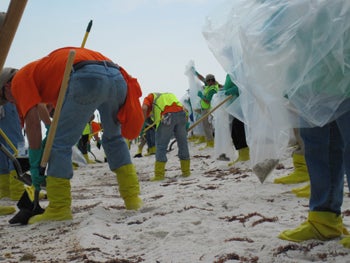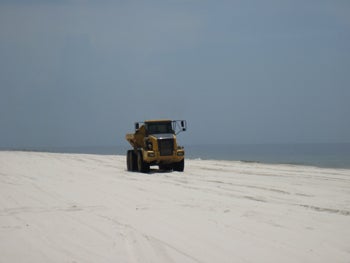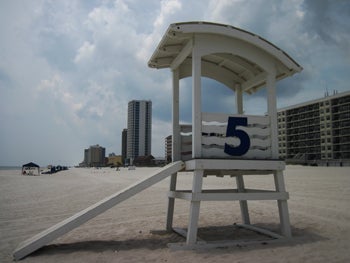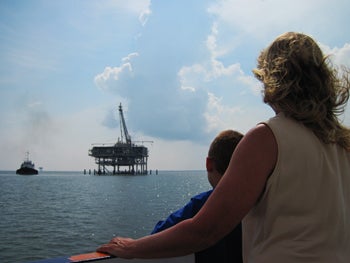
La página que intenta visitar sólo está disponible en inglés. ¡Disculpa!
The page you are about to visit is currently only available in English. Sorry!


An army of workers cleans tar balls from a beach in Florida's Perdido Key State Park. Today is their first day on the job, they plan to stay the summer. (Photo by Justin Nobel/Audubon Magazine)
Perdido Key, Florida, June 17
Standing on the slippery deck of a car ferry in Mobile Bay, I meet a grandma with pink toenail polish. “There a lot of furious people down here,” she says. “Me as one of them.” Her name is Donna and because of the oil spill the crab shop she works at has shut for the summer. With no one crabbing, shrimping or gathering oysters in southeast Louisiana, Mississippi or Alabama, they have nothing to sell. Beside her are two tykes in swim trunks, Donna’s grandkids, down from North Carolina. “I took the kids last year to Dauphin Island to swim and they loved it,” she says. “I took them the other day and we got tar all over our feet.” She looks at the tykes. “Nanny aint gonna let you get in the water here, it’s giving people rashes.”
Last week, oil washed ashore in Alabama and Florida and this week, NOAA trajectory maps have it hitting again. After five weeks of tracking the spill across Louisiana, I hit the highway east then cut south to the Alabama coast on a two-lane road, passing shrimp shacks and billboards for vacations in turquoise waters. What I find is frightening: without tourists or seafood, businesses are shutting down and wildlife managers are forging their own solutions, with dire consequences.

A dump truck hauls oiled sand from a snow white beach on Bon Secour National Wildlife Refuge, in Alabama. "If you keep hauling sand off the beach, you're going to get a cliff too sharp for sea turtles to come up," says refuge spokesperson Jim Burkhart. (Photo by Justin Nobel/Audubon Magazine)
In piney woods near Fort Morgan, Alabama is the park office for Bon Secour National Wildlife Refuge, a necklace of protected white beaches and barrier woodlands with nearly 400 species of birds and three types of sea turtle. "Last Friday around 10 a.m., sheets of liquefied oil started coming in," says refuge spokesperson Jim Burkhart, a talkative man with a white beard and a hunting cap. "It kind of had a crimson color, like they just threw red Jell-O up on the beach, it was chaos.” Five days later, crews are still cleaning it up. “Fish and Wildlife is all about critters and habitat,” he says. “Unfortunately it’s the habitat that’s being affected, and once you got all these critters and nowhere to live, then what you’ve got is a big bad problem.”
Jim leads me down a beach access road choked with contractor pickups. To keep the boardwalk clean Jim has duct taped over it a path of industrial carpet, which is now smeared with orange oil footprints. We cross over low grassy dunes, habitat for countless birds and an endangered beach mouse. The beach is a scorching white blanket of sand, too bright to look at; thundering up and down it are Mack trucks. Hand crews couldn’t remove the oil quickly enough and tides have buried it in sand. The only way to remove the oil now is with heavy equipment, says Jim. Caterpillars scoop beach into dump trucks, which pile it in a clearing in the pines, where other Cats scoop it into other dump trucks, which bring it to a landfill. The impromptu plan has worked for now, but with oil still lurking just offshore, Jim worries what comes next. “If you keep hauling sand off the beach you’re going to get a cliff too sharp for sea turtles to come up,” he says.
Come July and August, loggerhead, green and Kemp’s ridley sea turtles will cross this beach to lay eggs. As I cross it my boots squish in the sand, which is riddled with minor valleys and ridges from the constant machinery traffic. Near the bottom of the beach is a stripe of tar balls. “Here’s one of the casualties,” says Jim, and kicks a crushed crab. He gazes out across the Gulf, which is flat, blue and shimmering in the heat. A single fishing boat is skimming oil. "A lot of us are still learning this stuff and that's problematic," he says. “It’s just hard to believe when you’re standing here what a disaster this is.”

The beach at Gulf Shores, Alabama is typically so crowded you have to step over people to get to the water. Now it is empty and a sign in the parking lot advises the public not to swim because of "the presence of oil-related chemicals." (Photo by Justin Nobel/Audubon Magazine)
Further east is Gulf Shores, an Alabama beach town loaded with surf shops and seafood restaurants. Peach and cream colored condo towers bookend the public beach, which is wide as a football field and mostly empty. A sign in the parking lot advises the public not to swim because of “the presence of oil-related chemicals.” In a gazebo at the top of the beach, I meet the Brown’s, a family of four who have just driven from Selma, four hours to the north. They have been vacationing here since their two college-aged girls, Helen and Hays, were infants. “You’re usually stepping over people to get to the beach,” says Helen. I ask why they didn’t go elsewhere this year. “We live in Alabama, so this is where we go,” says Helen's mother Susannah, almost in tears. “I don’t even want to go out there,” she says.
I pass a Hooters, the only crowded restaurant and enter Florida. At Perdido Key State Park, I pull into a sandy parking lot. On the other side of the dunes, the water is turquoise, like advertised on the billboard back in Alabama. Only now, the beach is littered with a thin ribbon of turd-like brown pellets, tar balls. Under a dark sky brimming with afternoon storms is gathered a group of nearly one-hundred cleanup workers. "It's not a hard job guys, you can do this," says a sun-tanned man in a straw hat who is giving a sort of oil cleaning pep talk. "Remember, we're here for the money, we're here for the beaches."
Today is the group's first day on the job. The workers wear identical green and orange T shirts and look like a cross-section of a city bus. Many are young, some are old, many are black, some are white. Overall, they are sullen, slightly confused and a bit overheated.
Justin Nobel/Audubon Magazine

Donna Hodge and her grandson Hayden examine one of the many oil platforms in Mobile Bay, Alabama. "Two, three, four, five, twelve," counts Hayden. "There are like 1,000 of them." Donna recently lost her job at a crab shop because of the spill. (Photo by Justin Nobel/Audubon Magazine)